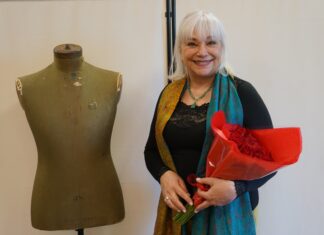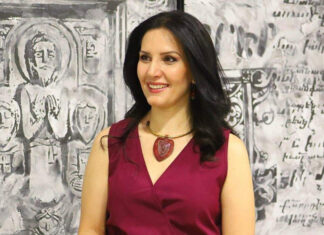By Will Friedwald
NEW YORK (Wall Street Journal) — The central image of the exhibition “Music for Moderns: The Partnership of George Avakian and Anahid Ajemian” shows the young couple traveling somewhere in Europe in 1949, standing next to both a train and an automobile. Somehow that seems like a perfect metaphor for the Avakians: He is one of the greatest record producers in the history of jazz, while she was a concert violinist and a leading figure in the world of contemporary classical music. A locomotive and a car are inherently different kinds of vehicles, but they both can transport you from one place to another and, ultimately, get you to where you’re going.
“Music for Moderns,” at the New York Public Library for the Performing Arts through September 24, is an exhibit of personal photographs, album covers, contracts, vintage news releases, concert programs and other items from the couple’s papers. The exhibition is dedicated to Ajemian, who died on June 13, a few weeks before it was scheduled to open.
The most striking feature of the show is an impressive sequence of larger-than-life reproductions of classic albums produced by Avakian that line the upper walls of the Astor Gallery — from his pioneering 78 rpm collections (he is generally credited as having produced the very first jazz albums), starting in 1940, to his heyday as the head of multiple divisions at Columbia Records in the 1950s and later work with such notable jazz postmodernists as Charles Lloyd and Keith Jarrett.
Avakian has an impressive track record in producing what are widely regarded, in many cases, as the greatest works by the major names in jazz, such as “Ellington at Newport,” “Louis Armstrong Plays W.C. Handy” and Miles Davis’s “Miles Ahead,” as well as two of the most celebrated live albums ever, Benny Goodman’s classic 1938 Carnegie Hall Concert (which gave us the essential version of Sing, Sing, Sing) and Erroll Garner’s “Concert by the Sea.”
The exhibition is organized largely around Avakian’s relationships with these jazz giants, starting with a 1936 interview he did with Goodman for his high-school newspaper, the Horace Mann Record. Then there are sections devoted to his work with Goodman, Armstrong (including Satchmo’s original lyric sheet to Mack the Knife, a hit single produced by Avakian), Duke Ellington, Miles Davis, Dave Brubeck, Sonny Rollins and others.









